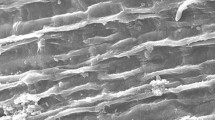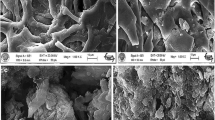Abstract
The main goal of this paper was to elaborate the possibility of industrial application of biosorption properties of Enteromorpha prolifera (production of mineral feed additives for livestock). In this study, biosorption process was used in the binding of chromium(III) ions from aqueous solution by the green macroalga. The kinetics of biosorption process was studied in a batch system with respect to the initial pH, temperature, initial metal ion concentration, and initial biomass concentration. E. prolifera demonstrated good biosorption properties. The equilibrium biosorption capacity increased with pH and with initial concentration of metal ions. The uptake of chromium(III) ions by the dried alga was affected by the temperature, but in small extent. With increase of the biomass concentration, the decrease of biosorption capacity at equilibrium was observed. The best biosorption conditions were determined as the initial pH 5, temperature 25 °C, the initial chromium(III) ions concentration 400 mg/L, and biosorbent concentration 1.0 g/L. Biosorption capacity at equilibrium reached at these conditions was 100 mg/g. The mechanism of the biosorption of chromium(III) ions by E. prolifera was analyzed in equilibrium experiments. Equilibrium data were fitted to Langmuir, Dubinin–Radushkevich, and Freundlich adsorption isotherms. The most suitable model for describing the obtained data was Langmuir model. The experimental results and the analysis of the solution before and after biosorption process suggested ion-exchange mechanism.








Similar content being viewed by others
References
Jensen, A. (1993). Hydrobiologia, 260/261, 15–23. doi:10.1007/BF00048998.
Pliński, M., Florczyk, I., & Galińska, M. (1988). Kieler Meeresforschungen. Sonderheft, 6, 265–271.
Nisizawa, K., Noda, H., Kikuchi, R., & Watanabe, T. (1987). Hydrobiologia, 151/152, 5–29. doi:10.1007/BF00046102.
Hou, X., & Yan, X. (1998). The Science of the Total Environment, 222, 141–156. doi:10.1016/S0048-9697(98)00299-X.
Aguilera-Morales, M., Casas-Valdez, M., Carrillo-Domínguez, S., González-Acosta, B., & Pérez-Gil, F. (2005). Journal of Food Composition and Analysis, 18, 79–88. doi:10.1016/j.jfca.2003.12.012.
Özer, A., Gürbüz, G., Çalimli, A., & Körbahti, B. K. (2008). Journal of Hazardous Materials, 152, 778–788. doi:10.1016/j.jhazmat.2007.07.088.
McDermid, K. J., & Stuercke, B. (2003). Journal of Applied Phycology, 15, 513–524. doi:10.1023/B:JAPH.0000004345.31686.7f.
Poole, L. J., & Raven, J. A. (1997). Progress in Phycological Research, 17, 1–148.
Mamatha, B. S., Namitha, K. K., Senthil, A., Smitha, J., & Ravishankar, G. A. (2007). Food Chemistry, 101, 1707–1713. doi:10.1016/j.foodchem.2006.04.032.
Bimalendu, R. (2006). Carbohydrate Polymers, 66, 408–416. doi:10.1016/j.carbpol.2006.03.027.
Lahaye, M., Ray, B., Baumberger, S., Quemener, B., & Axelos, M. A. V. (1996). Hydrobiologia, 326/327, 473–480. doi:10.1007/BF00047848.
Venkata Raman, B., Rao, D. N., & Radhakrishnan, T. M. (2004). Indian Journal of Clinical Biochemistry, 19, 105–109. doi:10.1007/BF02872402.
Podbielkowski, Z. (1978). Glony. Warsaw: Wydawnictwo Szkolne i Pedagogiczne.
Haroon, A. M., Szaniawska, A., Normant, M., & Janas, U. (2000). Oceanologia, 42, 19–28.
Szefer, P., & Skwarzec, B. (1988). Oceanologia, 25, 87–98.
Żbikowski, R., Szefer, P., & Latała, A. (2006). Environmental Pollution, 143, 435–448. doi:10.1016/j.envpol.2005.12.007.
Mabeau, S., & Fleurence, J. (1993). Trends in Food Science & Technology, 4, 103–107. doi:10.1016/0924-2244(93)90091-N.
Directive of Polish Minister of Agriculture and Rural Development. (2003). Act on resources of animal feeding. Journal of Laws, No. 29, Item 243.
McHugh, D. J. (2003). FAO Fisheries Technical Paper, 441, 1–105.
Oswald, W. J., & Gotaas, H. B. (1957). Transactions of the American Society of Civil Engineers, 122, 73–105.
Volesky, B. (1990). Biosorption and biosorbents. In B. Volesky (Ed.), Biosorption of heavy metals. Boca Raton: CRC.
Pessôa de França, F., Pinto Padilha, F., & da Costa, A. C. A. (2006). Applied Biochemistry and Biotechnology, 128, 23–32. doi:10.1385/ABAB:128:1:023.
Özer, A., Akkaya, G., & Turabik, M. (2005). Chemical Engineering Journal, 112, 181–190. doi:10.1016/j.cej.2005.07.007.
Özer, A., Akkaya, G., & Turabik, M. (2005). Journal of Hazardous Materials B, 126, 119–127. doi:10.1016/j.jhazmat.2005.06.018.
Hernández, I., Fernández-Engo, M. A., Pérez-Lloréns, J. L., & Vergara, J. J. (2005). Journal of Applied Phycology, 17, 557–567. doi:10.1007/s10811-005-9006-6.
Deviller, G., Aliaume, C., Nava, M. A. F., Casellas, C., & Blancheton, J. P. (2004). Aquaculture (Amsterdam, Netherlands), 235, 331–344. doi:10.1016/j.aquaculture.2004.01.023.
Vincent, J. B. (2001). Polyhedron, 20, 1–26. doi:10.1016/S0277-5387(00)00624-0.
N.R.C. (1997). The role of chromium in animal nutrition. Washington, DC: National Academy.
Chojnacka, K. (2007). World Journal of Microbiology & Biotechnology, 23, 1139–1147. doi:10.1007/s11274-006-9344-9.
Michalak, I., Zielińska, A., Chojnacka, K., & Matuła, J. (2007). American Journal of Agricultural and Biological Science, 2, 284–290.
Ho, Y. S., & McKay, G. (1999). Process Biochemistry, 34, 451–465. doi:10.1016/S0032-9592(98)00112-5.
Yongnian, N., Shouhui, C., & Serge, K. (2002). Analytica Chimica Acta, 46, 305–316.
Chojnacka, K. (2006). Talanta, 70, 966–972. doi:10.1016/j.talanta.2006.05.063.
Aksu, Z. (2001). Separation and Purification Technology, 21, 285–294. doi:10.1016/S1383-5866(00)00212-4.
Kumar, K. V., Sivanesan, S., & Ramamurthi, V. (2005). Process Biochemistry, 40, 2865–2872. doi:10.1016/j.procbio.2005.01.007.
Michalak, I., Chojnacka, K., Richter, D., Pietryka, M., & Matuła, J. (2006). Na pograniczu chemii i biologii. WN UAM in Poznan, 16, 107–116. in Polish.
Yun, Y. S., Park, D., Park, J. M., & Volesky, B. (2001). Environmental Science & Technology, 35, 4353–4358. doi:10.1021/es010866k.
Dönmez, G. Ç., Aksu, Z., Öztürk, A., & Kutsal, T. (1999). Process Biochemistry, 34, 885–892. doi:10.1016/S0032-9592(99)00005-9.
Yunus Pamukoglu, M., & Kargi, F. (2007). Enzyme and Microbial Technology, 42, 76–82. doi:10.1016/j.enzmictec.2007.08.004.
Tobin, J. M., Cooper, D. G., & Neufeld, R. J. (1984). Applied and Environmental Microbiology, 47, 821–824.
Kannan, N., & Sundaram, M. M. (2001). Dyes Pigm, 51, 25–40. doi:10.1016/S0143-7208(01)00056-0.
Langmuir, I. (1918). Journal of the American Chemical Society, 40, 1361–1403. doi:10.1021/ja02242a004.
McKay, G., Blair, H. S., & Gardner, J. R. (1984). Journal of Applied Polymer Science, 29, 1499–1514. doi:10.1002/app. 1984.070290504.
Freundlich, H. (1907). Zeitschrift für Physikalische Chemie, 57, 385–470.
Dubinin, M. M., & Raduskhevich, L. V. (1947). Proceedings of the Academy of Sciences of the USSR. Physical Chemistry Section, 55, 327–329.
Hasany, S. M., & Chaudhary, M. H. (1996). Applied Radiation and Isotopes, 47, 467–471. doi:10.1016/0969-8043(95)00310-X.
Helfferich, F. (1962). Ion exchange. New York: McGraw-Hill.
Onyango, M. S., Kojima, Y., Aoyi, O., Bernardo, E. C., & Matsuda, H. (2004). Journal of Colloid and Interface Science, 279, 341–350. doi:10.1016/j.jcis.2004.06.038.
Directive of Polish Minister of Agriculture and Rural Development. (2004). with further changes (2005). Acceptable amounts of undesirable substances in fodders. Journal of Laws, No. 162, Item 1704 and Journal of Laws, No. 151, Item 1267.
Commission Directive 2003/100/EC of 31 October 2003 amending Annex I to Directive 2002/32/EC of the European Parliament and of the Council on undesirable substances in animal feed, L 285/33.
Jamroz, D., Podkówka, W., & Chachułowa, J. (2004). Żywienie zwierząt i paszoznawstwo. Warsaw: PWN.
Acknowledgments
This research was financially supported by Ministry of Science and Higher Education (No. R05 014 01). We would also like to thank Professor Jan Matuła, Dr. Dorota Richter, and Dr. Mirosława Pietryka from the Department of Botany and Plant Ecology of the Wrocław University of Environmental and Life Sciences for identification of the alga.
Author information
Authors and Affiliations
Corresponding author
Rights and permissions
About this article
Cite this article
Michalak, I., Chojnacka, K. The New Application of Biosorption Properties of Enteromorpha prolifera . Appl Biochem Biotechnol 160, 1540–1556 (2010). https://doi.org/10.1007/s12010-009-8635-7
Received:
Accepted:
Published:
Issue Date:
DOI: https://doi.org/10.1007/s12010-009-8635-7




